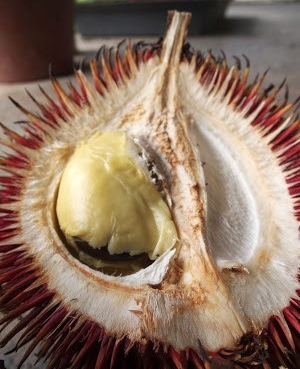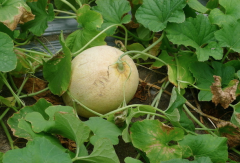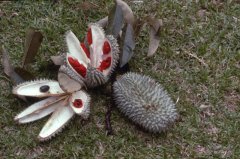How does the red-shelled durian grow and where? What are the taste characteristics of red-shell durian?
Everything about red-shelled durian is a little magical. This tree is one of the rarer durian and lives deep in the jungle of Borneo. In the season, red spheres dot the shady forest floor, like depraved Christmas ornaments, and sensational red leaps out of green leaves like green leaves. It is the strongest smell of durian, and it is said that its smell can pass through the jungle for a kilometer.
The red-shell durian has a bright red appearance, long and sharp thorns, and the tip is sometimes yellow or black. This is very difficult to open because it lacks the weakened seams that every other durian opens. You need a machete to open the red shell durian. Usually, simply beat the fruit in half and scrape off the sticky pulp with your fingers.
I used to laugh at durian cut in half like this. Now I see that everything has a time and a place.
In the case of red-shelled durian, the old maxim "smells like hell, but tastes like heaven" has been exaggerated. The smell of red-shelled durian is absolutely overwhelming. Although Durio graveolens literally means "stinky durian", the smell of red shell durian has by far the strongest aroma of , with intoxicating vapors of industrial gum, menthol and sugar.
Regardless of the sense of smell, everyone thinks that the flavor of red-shelled durian is unparalleled. The flesh is soft, almost full-bodied yellow, loosely covered with and covered with large, near-black seeds. This is the sweetest durian, like powdered sugar whipped into yogurt with a thin aftertaste. Anyone who likes mint chocolate will like this durian.
Although red-shell durian has excellent flavor and unparalleled enjoyment of durian lovers, it is only planted occasionally. It is not considered to be an economic interest, nor is it the subject of many studies. The tree is big, at least 40 meters high, and the flowers are lovely pink. Like most other durian, it occurs naturally in mixed lowland borneol forests in swampy areas and ridges up to 800 meters high. It is a strong tree and it has been suggested to be used as a rootstock for commercial durian farming.

- Prev

What are the varieties of cantaloupe? Introduction of black eyebrow red heart crisp yolk egg snow red Jiashi cantaloupe
Do you like cantaloupe? Do you know the common cantaloupe, which varieties are there? If you want to know, let's take a look at it. Xizhou honey: light hemp green, greenway, fine reticulation, orange flesh, fine meat, crisp, good flavor, sugar content
- Next

Durian variety introduction big flower durian, big flower durian characteristics distribution area can be planted
Of all the durian species in Borneo, I am most excited about the large flower durian, known locally as the ghost durian. I don't believe it will be hard to spot because it is obviously growing all over Borneo. I'm more concerned with finding the rare Durio testudinarum and
Related
- A course of planting techniques and methods on how to grow carrots
- How to plant the latest tulips?
- Is it better to pick tea in the morning or in the afternoon? When is the best time for tea to be picked? what is the third or fifth tea?
- Launch Yuanxiao Happy combination Haocha + Tea Yuan healthy Taste
- Penghu Tourism "Fireworks 20 Parade with You"
- 2022 West Lake Happiness holds "Digital Revitalization Voucher" and draws iphone13 and laptop.
- Banqiao Fuzhou social houses are designed to change start-up combined with police elimination to create a safe and livable environment
- The convenient measure of "mechanical weeding" in Xinbei has been abused and the Agriculture Bureau has imposed heavy penalties on the illegal land consolidation.
- Changgeng University Joins Hands with Four Memory Factories to Rescue Memory Talent Shortage
- The list of Taiwan's top 100 MVP managers is listed by the Director-General of the Farmers' Association of Sanxia District.

